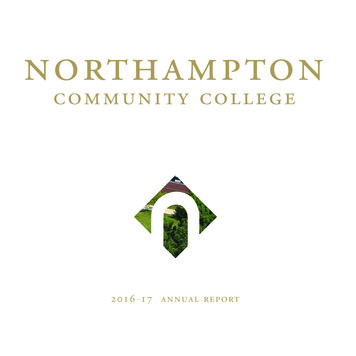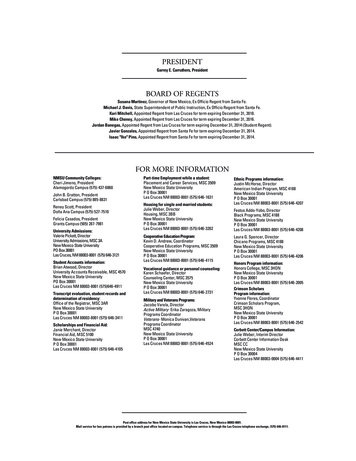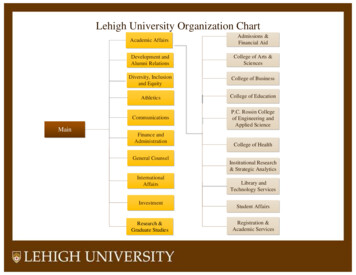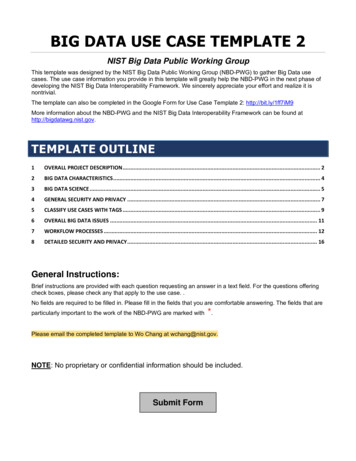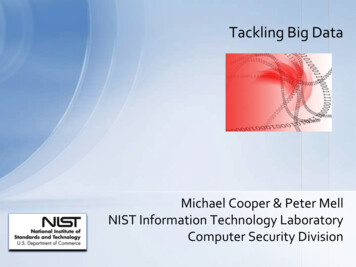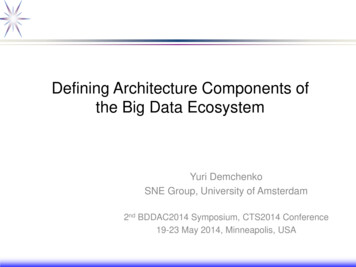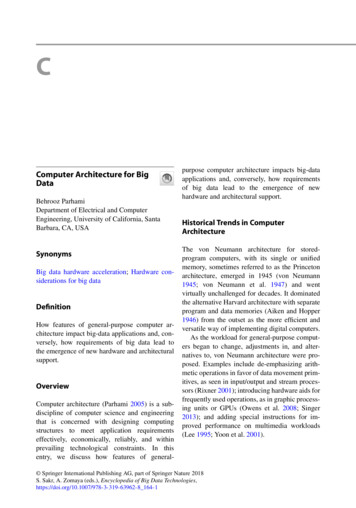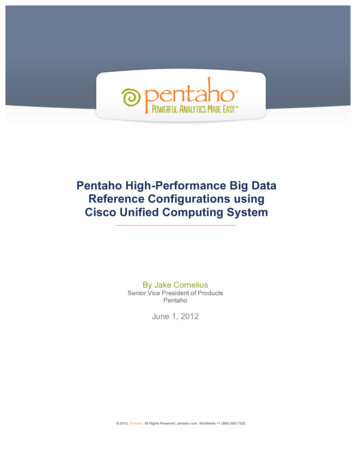
Transcription
taREPORT TO THE PRESIDENTBIG DATA AND PRIVACY:A TECHNOLOGICALPERSPECTIVEExecutive Office of the PresidentPresident’s Council of Advisors onScience and TechnologyMay 2014
REPORT TO THE PRESIDENTBIG DATA AND PRIVACY:A TECHNOLOGICAL PERSPECTIVEExecutive Office of the PresidentPresident’s Council of Advisors onScience and TechnologyMay 2014
About the President’s Council of Advisors onScience and TechnologyThe President’s Council of Advisors on Science and Technology (PCAST) is an advisory group ofthe Nation’s leading scientists and engineers, appointed by the President to augment the scienceand technology advice available to him from inside the White House and from cabinetdepartments and other Federal agencies. PCAST is consulted about, and often makes policyrecommendations concerning, the full range of issues where understandings from the domainsof science, technology, and innovation bear potentially on the policy choices before thePresident.For more information about PCAST, see www.whitehouse.gov/ostp/pcast
The President’s Council of Advisors onScience and TechnologyCo‐ChairsJohn P. HoldrenAssistant to the President forScience and TechnologyDirector, Office of Science and TechnologyPolicyEric S. LanderPresidentBroad Institute of Harvard and MITVice ChairsMaxine SavitzVice PresidentNational Academy of EngineeringWilliam PressRaymer Professor in Computer Science andIntegrative BiologyUniversity of Texas at AustinMembersS. James Gates, Jr.John S. Toll Professor of PhysicsDirector, Center for String and ParticleTheoryUniversity of Maryland, College ParkRosina BierbaumDean, School of Natural Resources andEnvironmentUniversity of MichiganChristine CasselPresident and CEONational Quality ForumMark GorenbergManaging MemberZetta Venture PartnersChristopher ChybaProfessor, Astrophysical Sciences andInternational AffairsDirector, Program on Science and GlobalSecurityPrinceton UniversitySusan L. GrahamPehong Chen Distinguished ProfessorEmerita in Electrical Engineering andComputer ScienceUniversity of California, Berkeleyi
Shirley Ann JacksonPresidentRensselaer Polytechnic InstituteCraig MundieSenior Advisor to the CEOMicrosoft CorporationRichard C. Levin (through mid‐April 2014)President EmeritusFrederick William Beinecke Professor ofEconomicsYale UniversityEd PenhoetDirector, Alta PartnersProfessor Emeritus, Biochemistry and PublicHealthUniversity of California, BerkeleyMichael McQuadeSenior Vice President for Science andTechnologyUnited Technologies CorporationBarbara SchaalMary‐Dell Chilton Distinguished Professor ofBiologyWashington University, St. LouisChad MirkinGeorge B. Rathmann Professor of ChemistryDirector, International Institute forNanotechnologyNorthwestern UniversityEric SchmidtExecutive ChairmanGoogle, Inc.Daniel SchragSturgis Hooper Professor of GeologyProfessor, Environmental Science andEngineeringDirector, Harvard University Center forEnvironmentHarvard UniversityMario MolinaDistinguished Professor, Chemistry andBiochemistryUniversity of California, San DiegoProfessor, Center for Atmospheric Sciencesat the Scripps Institution of OceanographyStaffMarjory S. BlumenthalExecutive DirectorAshley PredithAssistant Executive DirectorKnatokie FordAAAS Science & Technology Policy Fellowii
PCAST Big Data and Privacy Working GroupWorking Group Co‐ChairsWilliam PressRaymer Professor in Computer Science andIntegrative BiologyUniversity of Texas at AustinSusan L. GrahamPehong Chen Distinguished ProfessorEmerita in Electrical Engineering andComputer ScienceUniversity of California, BerkeleyWorking Group MembersEric S. LanderPresidentBroad Institute of Harvard and MITS. James Gates, Jr.John S. Toll Professor of PhysicsDirector, Center for String and ParticleTheoryUniversity of Maryland, College ParkCraig MundieSenior Advisor to the CEOMicrosoft CorporationMark GorenbergManaging MemberZetta Venture PartnersMaxine SavitzVice PresidentNational Academy of EngineeringJohn P. HoldrenAssistant to the President for Science andTechnologyDirector, Office of Science and TechnologyPolicyEric SchmidtExecutive ChairmanGoogle, Inc.Working Group StaffMarjory S. BlumenthalExecutive DirectorPresident’s Council of Advisors on Scienceand TechnologyMichael JohnsonAssistant DirectorNational Security and International Affairsiii
iv
EXECUTIVE OFFICE OF THE PRESIDENTPRESIDENT’S COUNCIL OF ADVISORS ON SCIENCE AND TECHNOLOGYWASHINGTON, D.C. 20502President Barack ObamaThe White HouseWashington, DC 20502Dear Mr. President,We are pleased to send you this report, Big Data and Privacy: A Technological Perspective, prepared for you by thePresident’s Council of Advisors on Science and Technology (PCAST). It was developed to complement and informthe analysis of big-data implications for policy led by your Counselor, John Podesta, in response to your requests ofJanuary 17, 2014. PCAST examined the nature of current technologies for managing and analyzing big data and forpreserving privacy, it considered how those technologies are evolving, and it explained what the technologicalcapabilities and trends imply for the design and enforcement of public policy intended to protect privacy in big-datacontexts.Big data drives big benefits, from innovative businesses to new ways to treat diseases. The challenges to privacyarise because technologies collect so much data (e.g., from sensors in everything from phones to parking lots) andanalyze them so efficiently (e.g., through data mining and other kinds of analytics) that it is possible to learn far morethan most people had anticipated or can anticipate given continuing progress. These challenges are compounded bylimitations on traditional technologies used to protect privacy (such as de-identification). PCAST concludes thattechnology alone cannot protect privacy, and policy intended to protect privacy needs to reflect what is (and is not)technologically feasible.In light of the continuing proliferation of ways to collect and use information about people, PCAST recommends thatpolicy focus primarily on whether specific uses of information about people affect privacy adversely. It alsorecommends that policy focus on outcomes, on the “what” rather than the “how,” to avoid becoming obsolete astechnology advances. The policy framework should accelerate the development and commercialization oftechnologies that can help to contain adverse impacts on privacy, including research into new technological options.By using technology more effectively, the Nation can lead internationally in making the most of big data’s benefitswhile limiting the concerns it poses for privacy. Finally, PCAST calls for efforts to assure that there is enough talentavailable with the expertise needed to develop and use big data in a privacy-sensitive way.PCAST is grateful for the opportunity to serve you and the country in this way and hope that you and others who readthis report find our analysis useful.Best regards,John P. HoldrenCo-chair, PCASTEric S. LanderCo-chair, PCAST
BIG DATA AND PRIVACY: A TECHNOLOGICAL PERSPECTIVE
BIG DATA AND PRIVACY: A TECHNOLOGICAL PERSPECTIVETable of ContentsThe President’s Council of Advisors on Science and Technology . iPCAST Big Data and Privacy Working Group . iiTable of Contents. viiExecutive Summary. ix1. Introduction . 11.1 Context and outline of this report . 11.2 Technology has long driven the meaning of privacy . 31.3 What is different today? . 51.4 Values, harms, and rights . 62. Examples and Scenarios . 112.1 Things happening today or very soon . 112.2 Scenarios of the near future in healthcare and education. 132.2.1 Healthcare: personalized medicine. 132.2.2 Healthcare: detection of symptoms by mobile devices . 132.2.3 Education . 142.3 Challenges to the home’s special status . 142.4 Tradeoffs among privacy, security, and convenience . 173. Collection, Analytics, and Supporting Infrastructure . 193.1 Electronic sources of personal data . 193.1.1 “Born digital” data . 193.1.2 Data from sensors . 223.2 Big data analytics. 243.2.1 Data mining . 243.2.2 Data fusion and information integration . 253.2.3 Image and speech recognition . 263.2.4 Social‐network analysis . 283.3 The infrastructure behind big data . 303.3.1 Data centers . 303.3.2 The cloud . 314. Technologies and Strategies for Privacy Protection . 334.1 The relationship between cybersecurity and privacy. 334.2 Cryptography and encryption . 35vii
BIG DATA AND PRIVACY: A TECHNOLOGICAL PERSPECTIVE4.2.1 Well Established encryption technology . 354.2.2 Encryption frontiers . 364.3 Notice and consent . 384.4 Other strategies and techniques . 384.4.1 Anonymization or de‐identification . 384.4.2 Deletion and non‐retention . 394.5 Robust technologies going forward . 404.5.1 A Successor to Notice and Consent . 404.5.2 Context and Use. 414.5.3 Enforcement and deterrence. 424.5.4 Operationalizing the Consumer Privacy Bill of Rights . 435. PCAST Perspectives and Conclusions . 475.1 Technical feasibility of policy interventions . 485.2 Recommendations . 495.4 Final Remarks .53Appendix A. Additional Experts Providing Input . 55Special Acknowledgment .57viii
BIG DATA AND PRIVACY: A TECHNOLOGICAL PERSPECTIVEExecutive SummaryThe ubiquity of computing and electronic communication technologies has led to the exponentialgrowth of data from both digital and analog sources. New capabilities to gather, analyze, disseminate,and preserve vast quantities of data raise new concerns about the nature of privacy and the means bywhich individual privacy might be compromised or protected.After providing an overview of this report and its origins, Chapter 1 describes the changing nature ofprivacy as computing technology has advanced and big data has come to the fore. The term privacyencompasses not only the famous “right to be left alone,” or keeping one’s personal matters andrelationships secret, but also the ability to share information selectively but not publicly. Anonymityoverlaps with privacy, but the two are not identical. Likewise, the ability to make intimate personaldecisions without government interference is considered to be a privacy right, as is protection fromdiscrimination on the basis of certain personal characteristics (such as race, gender, or genome). Privacyis not just about secrets.Conflicts between privacy and new technology have occurred throughout American history. Concernwith the rise of mass media such as newspapers in the 19th century led to legal protections against theharms or adverse consequences of “intrusion upon seclusion,” public disclosure of private facts, andunauthorized use of name or likeness in commerce. Wire and radio communications led to 20th centurylaws against wiretapping and the interception of private communications – laws that, PCAST notes, havenot always kept pace with the technological realities of today’s digital communications.Past conflicts between privacy and new technology have generally related to what is now termed “smalldata,” the collection and use of data sets by private‐ and public‐sector organizations where the data aredisseminated in their original form or analyzed by conventional statistical methods. Today’s concernsabout big data reflect both the substantial increases in the amount of data being collected andassociated changes, both actual and potential, in how they are used.Big data is big in two different senses. It is big in the quantity and variety of data that are available to beprocessed. And, it is big in the scale of analysis (termed “analytics”) that can be applied to those data,ultimately to make inferences and draw conclusions. By data mining and other kinds of analytics, non‐obvious and sometimes private information can be derived from data that, at the time of theircollection, seemed to raise no, or only manageable, privacy issues. Such new information, usedappropriately, may often bring benefits to individuals and society – Chapter 2 of this report gives manysuch examples, and additional examples are scattered throughout the rest of the text. Even in principle,however, one can never know what information may later be extracted from any particular collection ofbig data, both because that information may result only from the combination of seemingly unrelateddata sets, and because the algorithm for revealing the new information may not even have beeninvented at the time of collection.The same data and analytics that provide benefits to individuals and society if used appropriately canalso create potential harms – threats to individual privacy according to privacy norms both widelyix
BIG DATA AND PRIVACY: A TECHNOLOGICAL PERSPECTIVEshared and personal. For example, large‐scale analysis of research on disease, together with health datafrom electronic medical records and genomic information, might lead to better and timelier treatmentfor individuals but also to inappropriate disqualification for insurance or jobs. GPS tracking of individualsmight lead to better community‐based public transportation facilities, but also to inappropriate use ofthe whereabouts of individuals. A list of the kinds of adverse consequences or harms from whichindividuals should be protected is proposed in Section 1.4. PCAST believes strongly that the positivebenefits of big‐data technology are (or can be) greater than any new harms.Chapter 3 of the report describes the many new ways in which personal data are acquired, both fromoriginal sources, and through subsequent processing. Today, although they may not be aware of it,individuals constantly emit into the environment information whose use or misuse may be a source ofprivacy concerns. Physically, these information emanations are of two types, which can be called “borndigital” and “born analog.”When information is “born digital,” it is created, by us or by a computer surrogate, specifically for use bya computer or data processing system. When data are born digital, privacy concerns can arise fromover‐collection. Over‐collection occurs when a program’s design intentionally, and sometimesclandestinely, collects information unrelated to its stated purpose. Over‐collection can, in principle, berecognized at the time of collection.When information is “born analog,” it arises from the characteristics of the physical world. Suchinformation becomes accessible electronically when it impinges on a sensor such as a camera,microphone, or other engineered device. When data are born analog, they are likely to contain moreinformation than the minimum necessary for their immediate purpose, and for valid reasons. Onereason is for robustness of the desired “signal” in the presence of variable “noise.” Another istechnological convergence, the increasing use of standardized components (e.g., cell‐phone cameras) innew products (e.g., home alarm systems capable of responding to gesture).Data fusion occurs when data from different sources are brought into contact and new facts emerge(see Section 3.2.2). Individually, each data source may have a specific, limited purpose. Theircombination, however, may uncover new meanings. In particular, data fusion can result in theidentification of individual people, the creation of profiles of an individual, and the tracking of anindividual’s activities. More broadly, data analytics discovers patterns and correlations in large corpusesof data, using increasingly powerful statistical algorithms. If those data include personal data, theinferences flowing from data analytics may then be mapped back to inferences, both certain anduncertain, about individuals.Because of data fusion, privacy concerns may not necessarily be recognizable in born‐digital data whenthey are collected. Because of signal‐processing robustness and standardization, the same is true ofborn‐analog data – even data from a single source (e.g., a single security camera). Born‐digital andborn‐analog data can both be combined with data fusion, and new kinds of data can be generated fromdata analytics. The beneficial uses of near‐ubiquitous data collection are large, and they fuel anincreasingly important set of economic activities. Taken together, these considerations suggest that apolicy focus on limiting data collection will not be a broadly applicable or scalable strategy – nor onex
BIG DATA AND PRIVACY: A TECHNOLOGICAL PERSPECTIVElikely to achieve the right balance between beneficial results and unintended negative consequences(such as inhibiting economic growth).If collection cannot, in most cases, be limited practically, then what? Chapter 4 discusses in detail anumber of technologies that have been used in the past for privacy protection, and others that may, to agreater or lesser extent, serve as technology building blocks for future policies.Some technology building blocks (for example, cybersecurity standards, technologies related toencryption, and formal systems of auditable access control) are already being utilized and need to beencouraged in the marketplace. On the other hand, some techniques for privacy protection that haveseemed encouraging in the past are useful as supplementary ways to reduce privacy risk, but do notnow seem sufficiently robust to be a dependable basis for privacy protection where big data isconcerned. For a variety of reasons, PCAST judges anonymization, data deletion, and distinguishing datafrom metadata (defined below) to be in this category. The framework of notice and consent is alsobecoming unworkable as a useful foundation for policy.Anonymization is increasingly easily defeated by the very techniques that are being developed for manylegitimate applications of big data. In general, as the size and diversity of available data grows, thelikelihood of being able to re‐identify individuals (that is, re‐associate their records with their names)grows substantially. While anonymization may remain somewhat useful as an added safeguard in somesituations, approaches that deem it, by itself, a sufficient safeguard need updating.While it is good business practice that data of all kinds should be deleted when they are no longer ofvalue, economic or social value often can be obtained from applying big data techniques to masses ofdata that were otherwise considered to be worthless. Similarly, archival data may also be important tofuture historians, or for later longitudinal analysis by academic researchers and others. As describedabove, many sources of data contain latent information about individuals, information that can beknown only if the holder expends analytic resources, or that may become knowable only in the futurewith the development of new data‐mining algorithms. In such cases it is practically impossible for thedata holder even to surface “all the data about an individual,” much less delete it on any specifiedschedule or in response to an individual’s request. Today, given the distributed and redundant nature ofdata storage, it is not even clear that data, even small data, can be destroyed with any high degree ofassurance.As data sets become more complex, so do the attached metadata. Metadata are ancillary data thatdescribe properties of the data such as the time the data were created, the device on which they werecreated, or the destination of a message. Included in the data or metadata may be identifyinginformation of many kinds. It cannot today generally be asserted that metadata raise fewer privacyconcerns than data.Notice and consent is the practice of requiring individuals to give positive consent to the personal datacollection practices of each individual app, program, or web service. Only in some fantasy world dousers actually read these notices and understand their implications before clicking to indicate theirconsent.xi
BIG DATA AND PRIVACY: A TECHNOLOGICAL PERSPECTIVEThe conceptual problem with notice and consent is that it fundamentally places the burden of privacyprotection on the individual. Notice and consent creates a non‐level playing field in the implicit privacynegotiation between provider and user. The provider offers a complex, take‐it‐or‐leave‐it set of terms,while the user, in practice, can allocate only a few seconds to evaluating the offer. This is a kind ofmarket failure.PCAST believes that the responsibility for using personal data in accordance with the user’s preferencesshould rest with the provider rather than with the user. As a practical matter, in the private sector, thirdparties chosen by the consumer (e.g., consumer‐protection organizations, or large app stores) couldintermediate: A consumer might choose one of several “privacy protection profiles” offered by theintermediary, which in turn would vet apps against these profiles. By vetting apps, the intermediarieswould create a marketplace for the negotiation of community standards for privacy. The Federalgovernment could encourage the development of standards for electronic interfaces between theintermediaries and the app developers and vendors.After data are collected, data analytics come into play and may generate an increasing fraction ofprivacy issues. Analysis, per se, does not directly touch the individual (it is neither collection nor,without additional action, use) and may have no external visibility. By contrast, it is the use of a productof analysis, whether in commerce, by government, by the press, or by individuals, that can causeadverse consequences to individuals.More broadly, PCAST believes that it is the use of data (including born‐digital or born‐analog data andthe products of data fusion and analysis) that is the locus where consequences are produced. This locusis the technically most feasible place to protect privacy. Technologies are emerging, both in theresearch community and in the commercial world, to describe privacy policies, to record the origins(provenance) of data, their access, and their further use by programs, including analytics, and todetermine whether those uses conform to privacy policies. Some approaches are already in practicaluse.Given the statistical nature of data analytics, there is uncertainty that discovered properties of groupsapply to a particular individual in the group. Making incorrect conclusions about individuals may haveadverse consequences for them and may affect members of certain groups disproportionately (e.g., thepoor, the elderly, or minorities). Among the technical mechanisms that can be incorporated in a use‐based approach are methods for imposing standards for data accuracy and integrity and policies forincorporating useable interfaces that allow an individual to correct the record with voluntary additionalinformation.PCAST’s charge for this study did not ask it to recommend specific privacy policies, but rather to make arelative assessment of the technical feasibilities of different broad policy approaches. Chapter 5,accordingly, discusses the implications of current and emerging technologies for government policies forprivacy protection. The use of technical measures for enforcing privacy can be stimulated byreputational pressure, but such measures are most effective when there are regulations and laws withcivil or criminal penalties. Rules and regulations provide both deterrence of harmful actions andincentives to deploy privacy‐protecting technologies. Privacy protection cannot be achieved bytechnical measures alone.xii
BIG DATA AND PRIVACY: A TECHNOLOGICAL PERSPECTIVEThis discussion leads to five recommendations.Recommendation 1. Policy attention should focus more on the actual uses of big data and less on itscollection and analysis. By actual uses, we mean the specific events where something happens that cancause an adverse consequence or harm to an individual or class of individuals. In the context of bigdata, these events (“uses”) are almost always actions of a computer program or app interacting eitherwith the raw data or with the fruits of analysis of those data. In this formulation, it is not the datathemselves that cause the harm, nor the program itself (absent any data), but the confluence of thetwo. These “use” events (in commerce, by government, or by individuals) embody the necessaryspecificity to be the subject of regulation. By contrast, PCAST judges that policies focused on theregulation of data collection, storage, retention, a priori limitations on applications, and analysis (absentidentifiable actual uses of the data or products of analysis) are unlikely to yield effective strategies forimproving privacy. Such policies would be unlikely to be scalable over time, or to be enforceable byother than severe and economically damaging measures.Recommendation 2. Policies and regulation, at all levels of government, should not embed particulartechnological solutions, but rather should be stated in terms of intended outcomes.To avoid falling behind the technology, it is essential that policy concerning privacy protection shouldaddress the purpose (the “what”) rather than prescribing the mechanism (the “how”).Recommendation 3. With coordination and encouragement from OSTP,1 the NITRD agencies2 shouldstrengthen U.S. research in privacy‐related technologies and in the relevant areas of social sciencethat inform the successful application of those technologies.Some of the technology for controlling uses already exists. However, research (and funding for it) isneeded in the technologies that help to protect privacy, in the social mechanisms that influence privacy‐preserving behavior, and in the legal options that are robust to changes in technology and createappropriate balance among economic opportunity, national priorities, and privacy protection.Recommendation 4. OSTP, together with the appropriate educational institutions and professionalsocieties, should encourage increased education and training opportunities concerning privacyprotection, including career paths for professionals.Programs that provide education leading to privacy expertise (akin to what is being done for securityexpertise) are essential and need encouragement. One might envision careers for digital‐privacy expertsboth on the software development side and on the technical management side.1The White House Office of Science and Technology PolicyNITRD refers to the Networking and Information Technology Research and Development program, whoseparticipating Federal agencies support unclassified research in advanced
And, it is big in the scale of analysis (termed “analytics”) that can be applied to those data,
